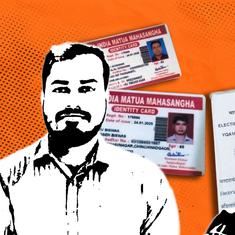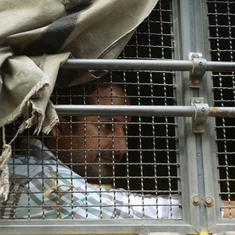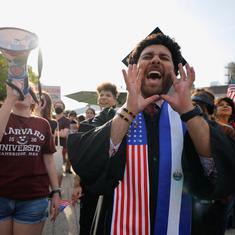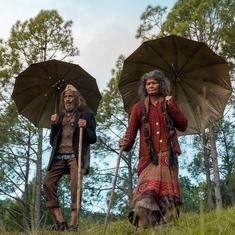She photographed the underbelly of urban life and the outcastes of society who were beloved to her, be it the junkies of Philadelphia, Seattle or the prostitutes of Mumbai’s Falkland Road. Hers was the first and among the few successful attempts to get into the life of Mumbai’s prostitutes while Indian photographers mostly looked at them from far away, fearing the "dirtiness" of their lives.
Mary Ellen Mark's photos of the brothels in Bombay's Falkland Road, taken in 1981 http://t.co/eZCgBHRMgD pic.twitter.com/UYPTDHKoCv
— Iva Dixit (@ivadixit) May 26, 2015In most Indian pictures of Falkland Road, the sex workers would be lazing around outside, some gazing out from behind the iron grills of their prison, their sorrow hidden behind their garish dresses. Mark won the confidence of her subjects. They talked and laughed with her and let her photograph their moments of put-on intimacy.
One picture specially stands out: The unbridled smile on the face of one of them peeping out from below the curtain as the deep veined hands of maybe her fifth customer of the day grabs her.
#MaryEllenMark, #Photographer and Force of Nature http://t.co/K9njE9tKew @nytimesphoto #photography pic.twitter.com/ozZUmrzbWR
— Jorge Rodríguez (@jrdelalamo) May 27, 2015India and Bombay which shut its eyes to them finally woke up to Falkland Road. It was Ellen Mark who saw them first as we never did.
Mary Ellen Mark’s beautiful book Falkland Road. Hard to find, expensive, but worth it. I saw it courtesy @busydot pic.twitter.com/ufvC65PKt6
— Richa Kaul Padte (@hirishitalkies) May 27, 2015
"Falkland Road (Mumbai's Red Light District) by Mary Ellen Mark (photographed in 1978) http://t.co/BTjDBcdlVu pic.twitter.com/CrL1ea8DTi"
— Reddit India Hot (@redditindiahot) January 24, 2015
Falkland Road, Bombay, India. 1978 prostitutes attract customers from cages on the street level. Mary Ellen Mark pic.twitter.com/ZH2BG0YK
— eva cruciani (@evacruciani) March 31, 2012
Melissa Harris, who edited several of Mark’s books told New York Times:
“She got to know the subjects she photographed very well, and she was able to convey who they were and how they lived, as well as a sense of their interior lives. There are not that many photographers who can do that.”
Maybe influenced by the commercial work of Annie Leibovitz, Ellen Mark moved to advertising during the 1990s. But she will be remembered for her work with the fringes of society and her total identification with them. "From the very first moment I took pictures [on the streets of Philadelphia], I loved it," Mark told the Inquirer’s Michael Matza in 1988. "The thrill was the idea of just being on a street, turning a corner and looking for something to see. It was just an amazing feeling... Photography became my obsession.... “
A distinguished line-up
Not counting Steve McCurry, she was among the last of a long line of western photographers who came to India with a dedicated interest, totally fascinated by what was hidden there and built up a body of work that the West came to know India by.
What did Ellen Mark and others see here in India that they did not see elsewhere? There was of course the rich colonial tradition of photography in India and its images had already penetrated the consciousness of the West. Photography came to India an year after it was invented. Calcutta and Mumbai, of course, played the lead in photography in colonial India. Elphinstone College started photography as a course in 1854 and a short lived photographic society came up in Bombay at the same time. Then of course there were Samuel Bourne and Charles Shepherd.
Mark, carved out her niche, keeping with the documentary nature of her work trying to look within the life of people on the margins. McCurry found the deep beauty of the rains and the deserts, and much earlier than them, during Partition and beyond, Henri Cartier Bresson, who would have influenced all the later arrivals from the West. We of course know Bresson mostly by his brilliant photographs of Gandhi’s last days and his funeral.
“The deep regard for people that is revealed in (Bresson’s) Indian photographs as well as in his photographs of any people anywhere in the world, invests them with a palpable humanism,” Satyajit Ray wrote in an introduction to Bresson's book. Ray could well have been writing about Mary Ellen Mark.
History, we often believe is the written word but, thankfully for us, there is a rich galaxy of images of the country that have embedded themselves in our collective memory. Though Indian photographers were brilliant, the Western photographers stand out like eternity: Bresson’s pictures of Gandhi’s funeral, his Muslim women praying on Hari Parbat Hill in Srinagar, Sebastiao Sagado’s Mumbai Dhobighat, and Churchgate Station (1995), Margaret Bourke-White's picture of Gandhi spinning, Mc Curry’s Rajasthan pictures. No one however showed us the darkness and smiles on the face of forgotten souls on the fringes of society on Falkland Road as Ellen Mark did. For that we have to remember this street photographer from New York.
RIP Mary Ellen Mark. I powerful Lady of Photography. #maryellenmark pic.twitter.com/h5tjkwZdr5
— David Cantwell (@commercialphoto) May 27, 2015









